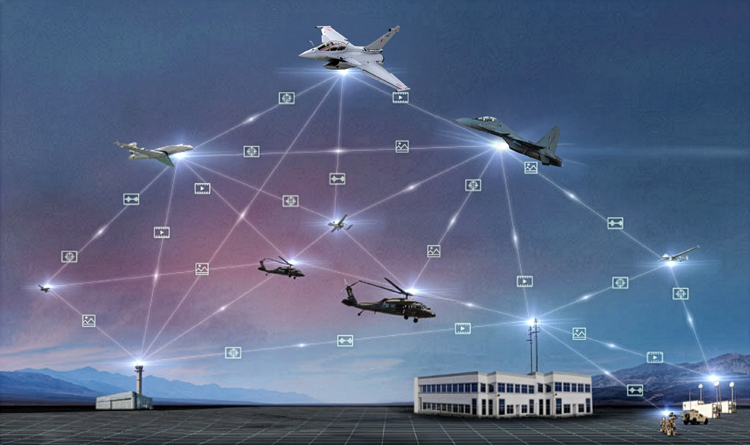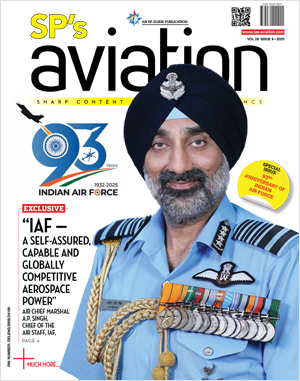INDIAN ARMED FORCES CHIEFS ON OUR RELENTLESS AND FOCUSED PUBLISHING EFFORTS

The insightful articles, inspiring narrations and analytical perspectives presented by the Editorial Team, establish an alluring connect with the reader. My compliments and best wishes to SP Guide Publications.

"Over the past 60 years, the growth of SP Guide Publications has mirrored the rising stature of Indian Navy. Its well-researched and informative magazines on Defence and Aerospace sector have served to shape an educated opinion of our military personnel, policy makers and the public alike. I wish SP's Publication team continued success, fair winds and following seas in all future endeavour!"

Since, its inception in 1964, SP Guide Publications has consistently demonstrated commitment to high-quality journalism in the aerospace and defence sectors, earning a well-deserved reputation as Asia's largest media house in this domain. I wish SP Guide Publications continued success in its pursuit of excellence.
- A leap in Indian aviation: Prime Minister Modi inaugurates Safran's Global MRO Hub in Hyderabad, Calls It a Milestone
- All about HAMMER Smart Precision Guided Weapon in India — “BEL-Safran Collaboration”
- India, Germany deepen defence ties as High Defence Committee charts ambitious plan
- True strategic autonomy will come only when our code is as indigenous as our hardware: Rajnath Singh
- EXCLUSIVE: Manish Kumar Jha speaks with Air Marshal Ashutosh Dixit, Chief of Integrated Defence Staff (CISC) at Headquarters, Integrated Defence Staff (IDS)
- Experts Speak: G20 Summit: A Sign of Global Fracture
Indian Air Force – Post Operation Sindoor
Operation Sindoor highlighted the evolving nature of modern warfare, underlining the need for doctrinal shifts and operational reforms. The focus now lies on integrating new technologies, strengthening joint capabilities, and adapting strategies to ensure readiness for future multi-domain challenges.

The Indian Air Force celebrated its 93rd anniversary on October 8, 2025, indeed a momentous occasion, especially in the backdrop of the stupendous success of Operation Sindoor. Swift, 88-hour operation once again underscored the importance of air power in today’s uncertain environment of shifting alliances, surging nationalism, hybrid and grey zone warfare and most importantly, no war no peace situation, as it exists in the Indian subcontinent. Operation Sindoor started as a counter-terror operation which rapidly expanded into conventional employment of air power, forcing Pakistani capitulation.
In a dynamic and uncertain landscape, India will rely heavily on the IAF to achieve national and security objectives while dealing with varied threats. While ensuring sovereignty of airspace, deterrence, nation building, and air diplomacy are peace-time functions, it is the wartime actions and experiences that provide insight into doctrinal, strategic and operational aspects. Operation Sindoor has raised some doctrinal and operational priorities for the IAF.
Operations Sindoor was primarily a joint operation led by air power, delivering a stronger response than Balakot. The operation evolved into a calibrated response growing in intensity after every counter by Pakistan. If this is any indication, future response to any act of terror supported by Pakistan is likely to be fiercer. The strategy of deterrence by punishment requires the IAF and other services to jointly plan a response much larger in scope. This multi-domain integrated approach necessitates integration of all five domains along with the sixth domain of information warfare, an area that needs review. This calls for accelerated integration of networks and strengthening space and cyber domains, and integration of manned and unmanned resources of the three services. Improvements in datalinks and common communication and software protocols need to be developed to ensure real-time synergy for cross-domain operations. A joint planning and coordination center at the apex level is imperative.
Multi-domain operations enable the development of kill web, a step above the kill chain, which is linear in nature and can be disrupted using cyber, electronic warfare or kinetic kill options against any link in the chain. Kill web provides redundancy and responsiveness against possible enemy disruptions, thus enhancing kill probability in air combat. Kill web uses assets in all domains, land, sea, air, space and cyber to identify the most efficient path to engage the target, thereby compressing sensor to shooter time. It involves a higher degree of AI infusion and automation. Absence of a single point of failure increases the probability of success and reduces vulnerability from enemy action. True multi-domain operations, including kill web, would demand multi-domain sensors and diverse shooters integrated by a secure and redundant network.
Information warfare and narrative building were observed as a weak area during Operation Sindoor. Information warfare must be an integral part of campaign planning
Operation Sindoor highlighted the importance of real-time ISR based on multiple sensors. All intelligence inputs from space-based surveillance to SIGINT, electronic warfare, cyber and HUMINT available from multiple agencies need to be processed in near real time for effective dynamic targeting since fleeting opportunities need to be capitalised. Fusing all these myriad inputs is imperative to achieve the desired effects.
The operation once again proved the utility of unmanned systems. Loitering munitions and Kamikaze drones played an important role. There is growing reliance on these systems; however, a balance between manned and unmanned systems should be achieved, considering the survivability of both manned and unmanned systems in contested airspace, especially against integrated layered air defence. Enhanced effects are possible by expanding long-range strikes using unmanned and expendable assets, to expose enemy air defence, which could be addressed by manned or unmanned long-range strike. Increasing reach of unmanned systems calls for hardening and dispersing our own manned assets even in depth.
Long-range weapons are inescapable in heavily defended airspace. Both air-to-air and air-to-ground weapons need to be developed and integrated to outrange the air-to-air and surface-to-air capability of the enemy. Development of modular, lowcost weapons that can be rapidly manufactured during a time of crisis will go a long way in saving precious resources and easing peacetime procurement requirements. Dedicated UCAV units must be created with doctrines for autonomous ISR, swarming strike packages, and attritable loitering munitions to provide massed effects without proportionate risk to pilots, especially against heavily defended targets and those out of range of air-to-ground weapons.
IAF is likely to field about 30-32 fighter squadrons in the 2030 timeframe against 25-26 squadrons if PAF and an equivalent of 50 PLAAF squadrons. This force structure would remain grossly inadequate to meet the ensuing threat. IAF is believed to be reviewing whether the presently approved 42.5 fighter squadrons are adequate to meet future threats. Manned-unmanned teaming options allow cost-effective solutions in achieving outcomes from the overall force structure. Operational philosophies and doctrinal changes needed in this endeavour could be reviewed.
Air Defence (AD) performed brilliantly during the operation. Integration of AD systems of IAF and Indian Army provided an impregnable defence against stand-off weapons, drones and missiles. Indigenous capability demonstrated the ability to integrate legacy and modern AD systems in a seamless architecture. Pakistan announced the formation of the Army Rocket Force Command, which is likely to be equipped with conventional ballistic and cruise missiles. China, on the other hand, has a large inventory of drones, conventional cruise and ballistic missiles. Air Defence will have to be scaled up for emerging threats. Existing resources, networks, integration and Command and control will have to be looked afresh to successfully implement Mission Sudarshan Chakra. Sensor-to-shooter time must be reduced from minutes to seconds at the tactical level while dealing with drone and missile threats. Dynamic Rules of Engagement (RoE) must be developed to ensure a proactive and uncompromising response. Review human-in-loop and human-on-loop boundaries in consonance with automation and infusion of AI into the decision support matrix.
Offensive and defensive multi-domain operations will have to be supported by integrating AI/ ML for command and control and decision support. Growing cyber/ EW threats demand accelerated development of quantum computing and quantum sensing solutions. Additionally, command nodes, datalinks and satellite communications need hardening. Plans must cater for operations in GNSS and RF denied environments.
Operation Sindoor demonstrated maturity in tri-service operations with inputs from both cyber and space domains. The synergy developed in recent years needs to be taken forward in the form of permanently manned joint operational planning cells for accelerated decision-making during crises. Formulation of a joint targeting plan would bring in greater efficiency in desired effects and optimal weapon to target matching to avoid duplication of effort. Operational plans must cater for mixed packages of manned and unmanned platforms.

Joint operations demand tri-service wargaming for multi-domain operations, factoring space and cyber effects. Building AI-enabled wargaming modules and holding regular whole-ofgovernment tabletop exercises, including narrative building, would enhance operational readiness and decision-making in an environment of decentralised execution. Shaping of internal and international opinion is important in a world dominated by realtime inputs from social media and electronic media. Understanding of international affairs, diplomacy, political and information dimensions of punitive action or operations is important for the team dealing with information operations. Information warfare and narrative building were observed as a weak area during Operation Sindoor. Information warfare must be an integral part of campaign planning.
This multi-domain integrated approach necessitates accelerated integration of networks and strengthening space and cyber domains, and integration of manned and unmanned resources of the three services
Operation Sindoor demonstrated the need to cater to high-intensity multidomain operations. Shifting alliances and complex global supply chains are likely to pose major challenges, especially for the imported equipment. IAF should work out a list of critical items that could be potential show stoppers for indigenisation in mission mode. Establishment of Joint Logistics Nodes is a welcome step; however, this needs to be expanded to achieve the ultimate goal in supply chain management. The operation brought out the importance of long-range weapons and surface-to-air missiles. These will be needed in large numbers, and so their scaling and stocking could be reviewed. Integration of indigenous weapons on all platforms needs to be pursued.
Operation Sindoor was a stupendous success. It demonstrated maturity in joint warfare. Revolution in drone warfare, cyber and growing effects of space on warfare are impacting the character of how wars will be conducted in the future. To achieve cross-domain effects in multi-domain operations, desired effects need to be weighed against capabilities in each domain. A balance between unmanned and manned systems for offensive operations needs to be evolved at the strategic level. The success of Operation Sindoor has certainly forced our adversaries to rethink their doctrine and operational philosophy. Increasing reliance on drones and missiles for non-contact multi-domain operations demands that IAF review some of its doctrinal percepts and operational philosophies for deterrence and integrated effect-based operations and scalable unmanned capabilities to maximise effects with mannedunmanned philosophy with increased reliance on AI/ML to ensure IAF remains ahead of future threats.





